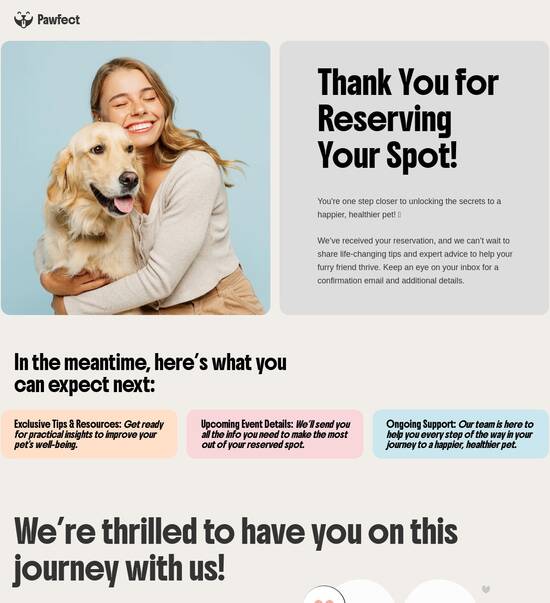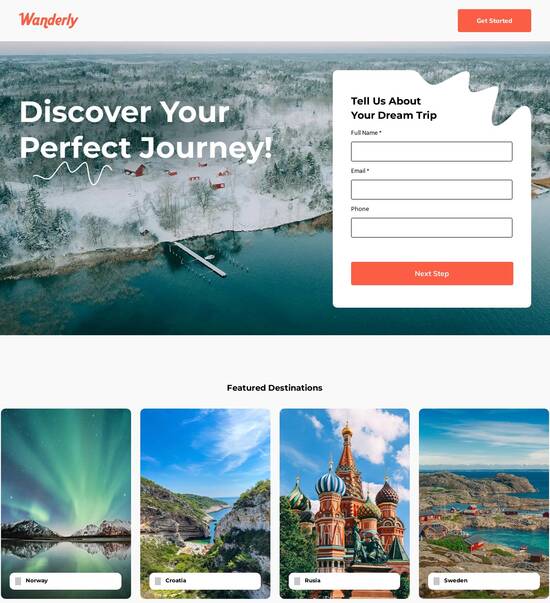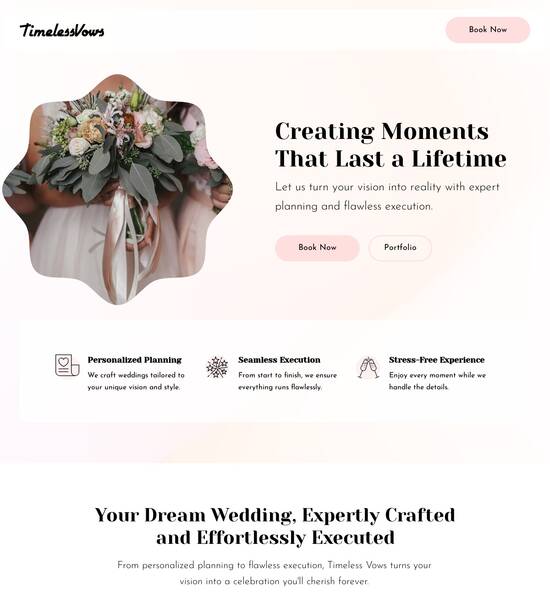
Eye-catching portfolio website template
Explore Similar TemplatesAbout template
Drive more leads with Instapage eye-catching portfolio website template built to maximize conversions. Easy customization - no designer or coding skills needed.
Recommended templates

Easy to build without coding
With the intuitive drag-and-drop builder, anyone on your team can create high-converting pages without any knowledge of code or design. Make enhancements to your landing page with custom widgets using Javascript, HTML/CSS, or third-party scripts.

Multiple layouts for any industry and goal
Select from 500+ landing page layouts built to boost conversions across industry-specific scenarios. Customize them by adjusting fonts, adding images, and generating on-brand content with the AI assistant. Quickly scale with Instablocks® and Global Blocks that you can save, reuse, and update globally.

Loads fast and looks polished on any device
Every template is responsive, which means they present professionally on any device and load blazingly fast with our Thor Render Engine. You can also power them up with Google AMP technology to deliver an unparalleled mobile experience and drive higher conversions.

Robust analytics & experimentation
Get real-time updates and reporting across all your devices, showing the number of visitors, conversions, cost-per-visitor, and cost-per-lead. Launch AI-powered experiments, run A/B tests, and use heatmaps to analyze user behavior, then optimize your landing page to maximize conversions.







Easy to build without coding
With the intuitive drag-and-drop builder, anyone on your team can create high-converting pages without any knowledge of code or design. Make enhancements to your landing page with custom widgets using Javascript, HTML/CSS, or third-party scripts.
Multiple layouts for any industry and goal
Select from 500+ landing page layouts built to boost conversions across industry-specific scenarios. Customize them by adjusting fonts, adding images, and generating on-brand content with the AI assistant. Quickly scale with Instablocks® and Global Blocks that you can save, reuse, and update globally.
Loads fast and looks polished on any device
Every template is responsive, which means they present professionally on any device and load blazingly fast with our Thor Render Engine.
Robust analytics & experimentation
Get real-time updates and reporting across all your devices, showing the number of visitors, conversions, cost-per-visitor, and cost-per-lead. Launch AI-powered experiments, run A/B tests, and use heatmaps to analyze user behavior, then optimize your landing page to maximize conversions.
All the features you need to build lead-generating landing pages
Explore more featuresLearn how to build top-performing landing pages for any goal
FAQs
Leading the way in building high-performing landing pages





A step-by-step guide to maximizing your ROI with Instapage
Instapage stands out as a powerful landing page and conversion rate optimization (CRO) platform specifically designed to help marketers accelerate, optimize, scale, and maximize the return on investment (ROI) of their digital marketing campaigns. With its comprehensive suite of tools, Instapage allows you to create high-performing landing pages quickly and efficiently, regardless of your team's size or budget.
Understanding the importance of landing pages
Landing pages are critical in your marketing strategy, serving as the first point of contact between your audience and youroffer. By utilizing Instapage's platform, you can leverage its extensive features such as 100+ high-converting templates and lead generation elements to create pages that not only capture attention but also drive conversions.
- High-converting templates: Choose from over 100 templates specifically designed to increase conversion rates.
- Lead generation elements: Incorporate pre-built features to capture leads effectively.
- No coding required: Easily build pages with a flexible, user-friendly interface.
Step 1: Setting up your landing page
To kick off your process, familiarize yourself with Instapage’s intuitive page creation tools. Start by selecting a template that aligns with your campaign objective. Access the drag-and-drop editor to customize elements such as images and content that resonate with your target audience.
- Select a template that fits your content goals and audience preferences.
- Utilize the drag-and-drop feature to seamlessly add or remove elements.
- Preview your landing page to ensure it meets your standards before publishing.
Step 2: Optimizing for conversions
After creating your landing page, utilize Instapage's built-in A/B testing and heatmap analytics to identify user behavior and enhance the page’s performance. This data will offer insights into how visitors interact with your page, allowing you to make informed tweaks for optimization.
- Conduct A/B tests to compare different versions of your page and identify which performs better.
- Use heatmaps to visualize user engagement and make necessary adjustments.
- Continuously monitor performance metrics to refine your strategy over time.
Step 3: Personalizing your audience experience
Personalization increases engagement and conversion rates. Instapage allows you to deliver tailored content by dynamically replacing text based on audience segments. This targeted approach ensures your landing pages speak directly to the needs of your visitors.
- Utilize dynamic text replacement to make headlines and copy more appealing to specific audiences.
- Leverage AdMaps to align your ads with the corresponding landing pages.
- Track audience-specific performance metrics for more strategic insights.
By following these steps, you can efficiently harness the full potential of Instapage, leading to a significant improvement in your overall marketing effectiveness.
Start optimizing your campaigns with Instapage today. Sign up for a free trial and experience the transformation of your marketing efforts into profitable outcomes.
People also ask about Eye-catching portfolio website template
Eye-catching portfolio website templates: A guide to making your work stand out
Understanding eye-catching portfolio website templates
Eye-catching portfolio website templates are specifically designed frameworks that enable creators—from photographers to graphic designers—to showcase their work in an appealing and organized manner. These templates are essential for professionals looking to make a strong impression in their respective industries. By combining intuitive design with functional elements, these templates serve the dual purpose of presenting one’s work while also facilitating user engagement.
In the creative fields, a portfolio is more than just a collection of previous work; it’s a personal brand statement. A well-designed template can highlight unique skills, set the creative tone, and convey professionalism, making it an integral part of building a successful career in design, art, or technology.
Aesthetics: Visually striking elements that pull viewers in.
Functionality: Features that allow easy navigation and accessibility.
Consistency: A cohesive look that reflects the creator's brand.
Critical features of portfolio website templates
Responsive design is a cornerstone of any modern template. Given the variety of devices people use, it is crucial that a portfolio website displays well on anything from desktops to smartphones. Templates that prioritize mobile compatibility tend to offer a better user experience, ensuring that your work is showcased effectively regardless of the viewer's platform.
Several templates excel in responsiveness, providing fluid layouts that adapt to different screen sizes. Highlighting these examples not only assists potential users in their decision-making but also sets a benchmark for quality. Customization options are equally significant; they allow users to personalize aspects such as colors, logos, and typography, making the template reflective of their individual style.
Gallery functionality is another critical feature. Providing various styles for presenting work—such as grids, sliders, and carousels—enhances visual appeal and can cater to different types of content. Best practices for showcasing work effectively suggest maintaining balance in design and ensuring that the presentation supports rather than distracts from the work itself.
The impact of user experience (UX) on design
User experience plays an essential role in a portfolio's effectiveness. Intuitive navigation is key to ensuring that visitors can easily explore your work. Simplifying the user journey through clear menu structures and strategic layout decisions leads to higher engagement and retention rates. A feature that allows visitors to ‘View Templates’ can further enhance exploration, enabling users to navigate through your projects seamlessly.
Loading speed is another crucial aspect that often gets overlooked. Studies show that website speed significantly impacts visitor retention; users are more likely to abandon a portfolio that takes too long to load. Suggestions for optimizing graphics without sacrificing quality include compressing images and utilizing modern file formats that maintain high resolution at low file sizes, which is particularly important for image-heavy portfolios.
Showcasing your work: Best practices
When it comes to choosing the right examples for your portfolio, selection is everything. Curating a collection that highlights both your skills and your growth over time will resonate with viewers. Consider showcasing projects that demonstrate your versatility, creativity, and technical prowess. Think critically about which pieces best represent your journey as a creator and the standards you uphold.
Strategic layouts can also enhance your portfolio's impact. For instance, horizontal layouts can lend a sense of spaciousness, allowing featured projects to breathe, while vertical layouts can create a more dynamic scrolling experience. Highlighting prominent projects prominently ensures they don’t get lost among numerous examples, helping to focus viewer attention where it matters most.
Select pieces that showcase a range of skills.
Ensure visual consistency across your showcased work.
Utilize layouts that enhance rather than detract from the work.
Incorporating interactive elements
Integrating interactive elements into your portfolio can elevate user engagement dramatically. Using animations and transitions adds a layer of dynamism that can captivate audiences without being overwhelming. Subtle motions can guide users’ focus, leading them to key aspects of your showcases, while frequent motions maintain a modern aesthetic.
Incorporating social proof, such as client testimonials and critiques, also serves to build trust with your audience. Displaying reviews or accolades effectively communicates the quality of your work and can significantly influence potential clients. One effective strategy could be to create a dedicated section for reviews or to integrate feedback throughout your portfolio entries.
The importance of a professional policy section
Having a clear policy section on your portfolio website can mitigate potential misunderstandings with clients and visitors. It’s essential to clearly outline copyright and usage rights, as this fosters confidence among potential collaborators. In a landscape where work can easily be misused or misrepresented, a well-defined policy acts as a safeguard.
Furthermore, including a straightforward contact policy encourages users to reach out for inquiries or collaborations, promoting open communication between you and your audience. Visitors appreciate transparency, and having a clear set of guidelines and expectations can lead to fruitful professional relationships.
The team behind the template: Collaboration and feedback
The process of designing effective portfolio website templates often involves collaboration among various stakeholders, particularly web designers. By pooling insights from different perspectives, teams can create templates that are more intuitive and align better with user needs. This collaborative approach enhances the quality of the final product.
Utilizing feedback throughout the design process is equally important. By actively seeking input from users and stakeholders, designers can refine designs, addressing any issues before launch. When weighing between hiring a designer and using a template, consider factors such as budget, time constraints, and the level of customization needed. Templates provide a cost-effective and time-efficient solution for many, but custom designs can offer unique branding opportunities.
Streamlining the building process
Starting your portfolio can be a straightforward process if approached methodically. A step-by-step guide can help streamline the creation of your website. Begin with a checklist that includes selecting and downloading an appropriate template, customizing it to suit your style, and populating it with relevant, high-quality images of your work.
After customization, take additional time to review and test the site across devices. The process doesn’t end at filling in your information; regular updates and maintenance are vital in keeping your portfolio relevant and engaging.
Review various template options before selection.
Customize the template to align with your branding.
Ensure mobile responsiveness through testing.
Writing articles and content for your portfolio
Crafting descriptive case studies is an important aspect of any portfolio. A narrative approach can enhance the presentation of your projects, giving potential clients insight into your process, challenges faced, and the solutions implemented. Structuring these case studies engagingly will capture viewers' interest and allow them to connect better with your work.
Optimizing content for SEO can further increase visibility. Strategies for writing compelling articles that resonate with your target audiences include using relevant keywords, writing engaging meta descriptions, and structuring content for readability. Employing tools such as Google Analytics can help track performance and inform future improvements.
The final touches: Review and launch
Before launching your website, conducting thorough quality assurance checks is essential. A checklist should include verifying all links are functional, assessing the site's responsiveness across devices, and ensuring readability and design consistency. These checks are crucial for providing a seamless experience for your visitors.
Once the site is ready to go live, making a lasting impression begins with how you announce it to your audience. Strategically utilizing social media platforms, email newsletters, or even collaboration invites can significantly help in driving traffic. Engaging with visitors immediately following launch can nurture interest and build a following.
Evolving your portfolio
Regularly updating your portfolio is imperative to maintaining relevance. As you grow as a creative, your portfolio should reflect not only your newest work but also any new skills or shifts in your career focus. Developing adaptive strategies for portfolio management can ease this process, allowing for seamless inclusions of fresh projects and insights.
Engaging with your audience through social media integration can facilitate community building around your portfolio. Techniques such as commenting, sharing insights about the work process, and responding to queries can help forge ongoing connections with both potential and existing clients.
Update your portfolio regularly with new work.
Monitor industry trends and incorporate them as necessary.
Utilize social media platforms for ongoing engagement.
Ready to skyrocket conversions?
Supercharge your ad campaigns with high-performing landing pages
Get started














